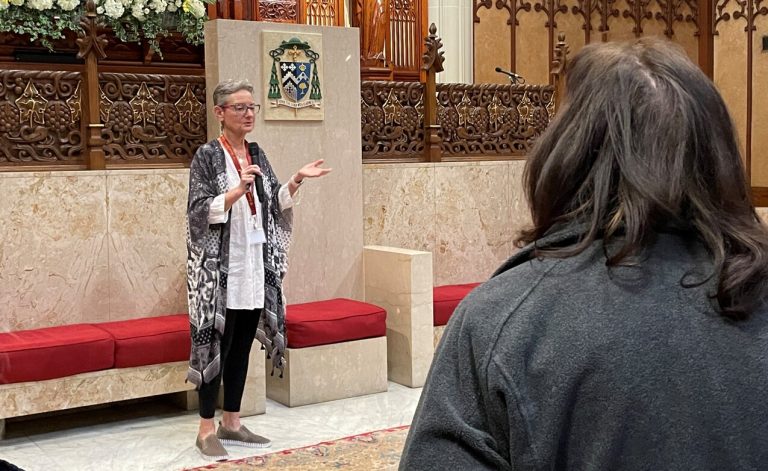Visit the Cathedral of Saint John the Evangelist in downtown Cleveland is an unusual experience for many people. In order to allow a greater number of faithful to experience the mother Church of the diocese, Theology on the West Rocks recently organized a tour of the cathedral.
Diane Fusco, a long-time cathedral parishioner and host, guided visitors through the church and pointed out many interesting things while informing them of its history and significance. The cathedral is the bishop’s church, which is obvious because it is where the cathedra, or special seat used by the bishop, is located.
(See photo gallery above.)
Fusco said the cathedral census includes about 1,100 households and about 1,700 people from across the diocese. “It’s a diverse group of people,” she said.
Before the establishment of the diocese in 1847, Cincinnati was the only diocese in Ohio. Amadeus Rappe was named the first bishop and one of the first decisions was where to locate the cathedral. A church already existed at The Flats (St. Mary), but the new bishop decided to purchase property at what is now East Ninth Street and Superior Avenue, Fusco said.
Construction began in 1848 and the first mass was celebrated in 1852. The current altar stands approximately where the original one stood. The building is neo-Gothic style.
“We look up when we walk in,” Fusco said, emphasizing that the building and its artwork are meant to inspire people and help transmit faith. “The pillars and arches transport us to heaven,” she added.
The windows were plain glass until the 50th anniversary of the diocese, when stained glass windows were installed. Fusco said the beauty of the windows reminds us of the glory to come.
The original church was made of red brick. During the Second World War, it was painted gray. There are paintings and other ornaments on the doors and scattered throughout the church. Fusco said that during the war, the cathedral was filled with people praying for the safety of the soldiers. After the war, in 1948, the cathedral was rebuilt and enlarged. Although there were plans to move it to the University Circle area, diocesan officials decided to keep it in the same location.
Fusco said various bishops have added their touch to the church. The stained glass windows show important scenes from Church history and help tell stories through images.
The great Holtkamp organ – it has 4,360 pipes – can be played in the choir loft or in front of the intricately carved wooden altarpiece made up of 850 pieces. The altarpiece, hand-carved from Appalachian oak, features statues of St. John the Evangelist as well as Matthew, Mark and Luke.
The three doors at the main entrance on East Ninth Street represent the Trinity. The Latin for we praise you, we bless you, we adore you is painted above the doors.
The Sacré-Cœur Chapel area contains an apocalypse mural. On the other side of the church is a shrine to Mary with statues of people important to the Blessed Mother, including her mother, Saint Anne, and Saint Joseph, her husband. The murals were created using the wet plaster technique.
The tabernacle table was fashioned from an ancient baptismal font. The altar installed in 1948 represents a pelican and the ambo presents a sculpture of Saint Stephen, deacon and martyr.
Fusco took the group into the sanctuary and showed them the cathedral with seating for priests on both sides. She also highlighted the coat of arms of Mgr Edward Malesic, affixed to the cathedral.
She also highlighted an icon given to the diocese for its 150th anniversary by the Byzantine Eparchy of Parma.
Inside the Chapel of the Resurrection are the tombs of two archbishops and eight bishops of the diocese as well as a complete set of relics of Saint Christina, martyr of the early Church.
Click on here to learn more about the cathedral and its history. Take a virtual tour here.
The following Theology on the rocks The program, scheduled for Aug. 14, will feature Auxiliary Bishop Michael Woost and his two brother priests, Father Dave Woost and Father Tom Woost. Details will be available soon.


